History is Not a Building: A Critical Analysis of Historic Preservation in the United States
Megan McKenzie
Advisor: Dr. Carma Gorman

Abstract
This thesis explores the foundations of the field of historic preservation, its current uses, and how the field could be improved to prevent the continued erasure of the history of marginalized communities within the built environment. Los Angeles County is examined as a microcosm of the U.S. due to its diverse population, rapidly changing demographics and neighborhoods, and fraught history of racist urban planning. The conventional criteria for historic designation first appeared in writing in 1965, and they effectively have not changed since; there are myriad problems with these criteria, which have made historic preservation a field ill-suited to commemorate the histories of people of color and other marginalized communities in the US. This thesis examines two case studies: the Blacker House, a quintessential example of traditional historic preservation at work, and the Circus Disco in Hollywood, exemplifying the community histories that historic preservation often fails to preserve. These two sites exemplify the breadth of sites that Americans are currently trying to preserve under the 1965 criteria for historic preservation, and suggest why those criteria are inequitable, biased, and ill-suited to today’s needs. In order to prevent the loss of more built histories, I argue that historic preservationists must reconsider what the field has accomplished in the past 90 years, and how its outdated frameworks and criteria can be recalibrated to ensure more equitable historic preservation outcomes in the future.